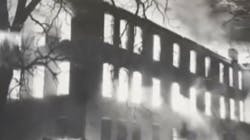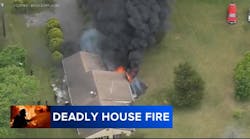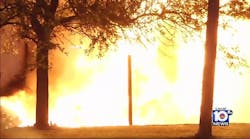Roy Porter remembers a distinct sound when he drives on Marquette Street and passes Genesis Medical Center's West campus.
He is haunted by a terrifying image. And he recalls a troubling smell.
The 95-year-old Porter is the last living firefighter on the scene Jan. 7, 1950, to witness the fire that destroyed St. Elizabeth's Hospital and claimed the lives of 41 people.
St. Elizabeth’s was part of the wider Mercy Hospital Complex, which housed men and women is separate asylums.
As the 70th anniversary of the terrible date approached, Porter offered his memories in the hopes " ... younger generations will realize just how important fire safety is in our lives."
He said he could never have imagined what he would experience as St. Elizabeth burned to the ground. He reached the scene around 2:30 a.m.
"You just have no way to really describe such a thing. But I remember, clearly, the sound of screaming. I've remembered that sound for as long as I've lived and whenever I go by the hospital's campus, I can still hear it," said Porter, who was part of Second Alarmers, a group of volunteers who worked with professional firefighters at major fires.
"We worked as support for the firefighters — especially at the scene of big fires," Porter explained. "Well, back then, I lived about seven or eight blocks from St. Elizabeth's Hospital. So I was there early, right as the firefighters were responding."
As he joined firefighters attempting to battle the blaze, Porter saw one woman trapped inside.
"She was at the window trying to push the bars away. And they were desperately trying to chop away the wood frame of the windows. For just a moment I saw her face," Porter said. "That look of fear. Her screams. And then there was that whooshing sound and she was gone.
"The fire took her. For two or three months after, that's what I saw, the image of that woman."
Porter said he sought the counsel of his pastor.
"I'm a Lutheran, and I went and talked to him about the emotional strain. He helped me believe the woman would be taken care of by the good Lord. I believe that, and that helped."
Porter pointed out the building — which was old in 1950 — was "ripe" for a catastrophic fire.
"A big brick building, all wood inside," Porter said. "Flammable furniture, old furniture. No smoke alarms. No fire extinguishers. And this is crucial — no sprinkler system.
"People complain all the time about having to put sprinkler systems into older buildings. Well, let me tell you, if today's standards had been in place in 1950 we wouldn't be talking about 41 dead people."
Porter is haunted by other details.
"It is the way we housed people back then," he said. "These were troubled people, I'm sure. But they were put in that old building and locked away with no way to get out.
"And there was, really, no way for us to get to most of them."
The official report from the investigation made it clear the building's design made rescue difficult. It said " ... practically all windows were securely barred on the outside or protected by heavy wire grilles. The bars consisted of steel rods spaced 4 inches apart on three flat horizontal bars which, in turn, were attached at each end to the wood window frames by large screws.
"With but one exception, it was necessary to chop the wood framing away at all three points on one side of the frame before the bars could be pried away."
It is not clear how many people were rescued from the flames. Forty-one were officially declared dead, 40 of them patients. The 41st was Anna Neal, a nurse. Sixteen victims are buried in Sacred Heart Cemetery on the grounds where the hospital stood.
It was the deadliest hospital fire in Quad-City and Iowa history. In fact, it remains the third-deadliest hospital fire ever in the United States.
Porter knows those facts are backed by real horror.
"You want to know how I live with that fire today? It's simple, really. I never stay anywhere that doesn't have a sprinkler system or a clear alarm system and safe evacuation routes," Porter said. "Where I live, I made sure there was a sprinkler system and access to extinguishers.
"And people should know we have very good fire and emergency services here in Davenport. Training, along with technology, saves lives and property every day. It's important people remember St. Elizabeth's, so they remember how important safety is today."
Finally, Porter returned to his own memories. He said he didn't want to talk about one.
"I never talk about it," he said. "In fact, I've never talked about it before. It's just so unpleasant.
"It was the smell. You're just never prepared for the first time you smell that smell. I hesitate to say this, but it was years before I could eat bacon. To this day, I'll still smell that smell.
"Even now, all of it is just so haunting. You just never want something like that to ever happen again."
———
©2020 Moline Dispatch and Rock Island Argus, Ill.
Visit Moline Dispatch and Rock Island Argus, Ill. at www.trib.com
Distributed by Tribune Content Agency, LLC.






